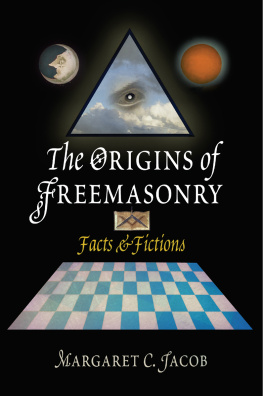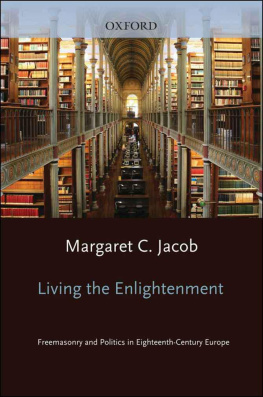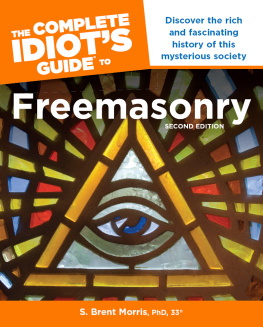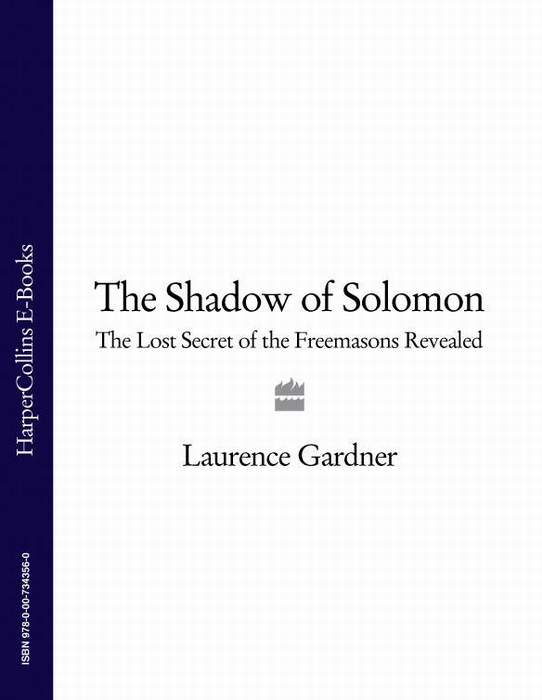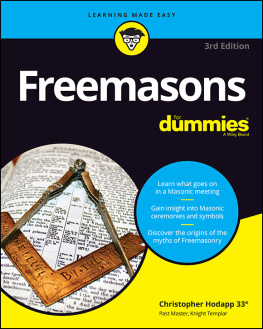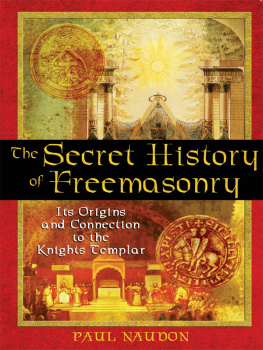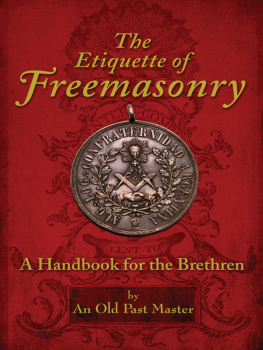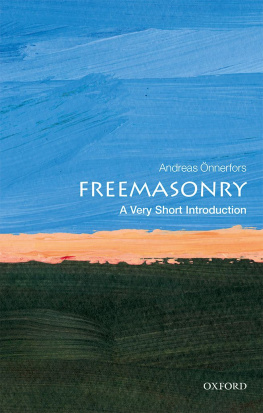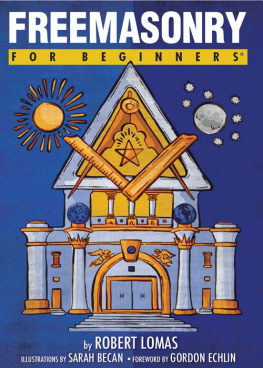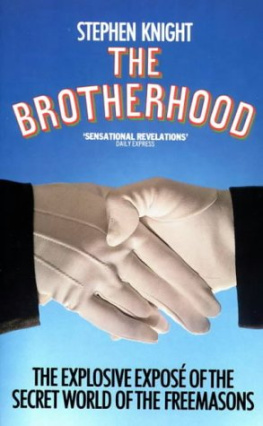
The Origins of Freemasonry
The ORIGINS of
FREEMASONRY
Facts & Fictions
MARGARET C. JACOB
UNIVERSITY OF PENNSYLVANIA PRESS
Philadelphia
Copyright 2006 University of Pennsylvania Press
All rights reserved. Except for brief quotations used for purposes of review or scholarly citation, none of this book may be reproduced in any form by any means without written permission from the publisher.
Published by
University of Pennsylvania Press
Philadelphia, Pennsylvania 19104-4112
Printed in the United States of America on acid-free paper
10 9 8 7 6 5 4 3 2 1
First paperback edition 2007
Library of Congress Cataloging-in-Publication Data
Jacob, Margaret C., 1943
The origins of freemasonry : facts & fictions / Margaret C. Jacob.
p. cm.
ISBN-13: 978-0-8122-1988-3 (pbk.: alk. paper)
ISBN-10: 0-8122-1988-0 (pbk.: alk. paper)
Includes bibliographical references and index.
1. FreemasonryHistory. I. Title.
HS403 .J28 2005
366.1dc22 2005042440
To the memory of the late Beitj Croiset van Uchelen (d. 1996), librarian of the archives and library of the Grand East of The Netherlands, and to its superb collection, located at the Cultural Masonic Center Prins Frederik, 9, Jan Evertstraat, The Hague, one of the finest collections in masonic history; open to all scholars.
CONTENTS
Introduction
In 2004 a best-selling novel, The Da Vinci Code, by Dan Brown told readers that the freemasons were descended from the Knights Templar. It is a great story, and as the author makes clear, part of a work of fiction. Somehow these fictions pass into fact. In November of the same year, Disney Productions released a feature film, National Treasure, about how the founding fathers left behind secret buried treasure. They were prone to secrecy because they were freemasons. Another great story, this one partly true. Some of the founding fathers, like George Washington and Benjamin Franklin, were freemasons. Before 2004 was out, people would be asking why the freemasons liked to bury treasure. In the late 1990s a furor erupted in Britain with enemies of the freemasons claiming that masonic policemen released criminals if they belonged to the order. To counter this bad press, a devotee wrote a history of freemasonry in which he claimed that they were descended from a group of reformers in the seventeenth century who called themselves Rosicrucians. No evidence was offered for that fictive story, but the author did at least cast a cold eye on the story about the freemasons and the Knights Templar. Separating masonic facts from masonic fictions can be difficult.
As a historian who has written about eighteenth-century freemasonry, I get asked all the timeeven by the company doing the film for Disney Productionsif the freemasons descended from the medieval Knights Templar, if the eye and triangle on the back of the American dollar bill was meant to be masonic, and not least, what are the secrets so guarded by the freemasons? This book attempts to answer some of those questions by looking at the first century of freemasonry, at its founding decades in eighteenth-century Europe. Reading about that history should dispel the notion about the Knights Templar as the origin of the masonic movement. But it should do more. Historical understanding asks readers to try to imagine what men like George Washington, Benjamin Franklin, Paul Revere, General Lafayette, and Voltaire (admitted late in life), Mozart, and the German poet Goethe might have found appealing in their masonic lodges.

FIGURE 1. Let us join him. This angel is knocking on the temple door for the secrets found in the anonymous exposure, the frontispiece to De Metselaar ontmomd [sic], of het rechte geheim der vryemetselaaren ontdekt 1753 (Arnhem: Jacob Nyhoff). With permission from the masonic library, Prins Frederik Cultural Masonic Center, The Hague; copyright Grand East of the Netherlands.

FIGURE 2. George Washingtons masonic apron. With permission of the Masonic Library and Museum of Pennsylvania, Philadelphia.
I want to remove the veil from a secret society that turns out not to be very secret at all. I want to read the original European books and archives from the eighteenth century and see what thousands of menamong them, in the colonies, our founding fathersand a few thousand women saw, what ideals the lodges sought to impart, what activities they promoted. I want to get closer to actual lives, but also to larger questions about the political implications of masonic membership. How did a private society dedicated to equality and fraternity cope with the pressures coming from a deeply hierarchical society, that was also increasingly dominated by market transactions, by wealth as distinct from birth. Those pressures mirror the tensions inherent in modern democracies, between the ideals of equality and the messy reality of status, wealth, privilege, and day-to-day inequality.
Much of what this book reveals depends upon European sources. American freemasonry derived directly from its British counterpart (as imported by Benjamin Franklin), and going back to the source of it all makes the most sense. I am also trained as a European and not an American historian, and I have not walked the archival terrain in the American libraries of the East Coast, the way I have in Europe. For the American side of the story, a fuller account can be found in the superb book by Steven Bullock, Revolutionary Brotherhood.
Perhaps American readers of this book will also be drawn to it because civic life at present seems so relatively impoverished. We join fewer groups; the average rate of membership in civic organizations is about one-tenth as large today as it was thirty years ago.stimulation, possibly an escape from rigidity in clan and chapel, led some eighteenth century menand womento seek the fellowship of freemasonry. This was true for American whites and blacks. For the latter, black lodges offered the possibility of self-governance. Documenting the history of masonic lodges in the old and new worlds of the eighteenth century can, however, be difficult. In some cases old world lodges felt that what they were doing was so important that historical records needed to be carefully preserved. But other lodges, especially those forand then bywomen left only traces.
Over the years I have visited just about every masonic library in western Europe. In the 1970s I started this search for the historical reality of freemasonry by asking for permission to begin where the original lodges began, in London in the 1690s. I wrote to the Library of the Grand Lodge of Great Britain, in Freemasons Hall on Great Queen Street, right in the heart of Soho, and requested permission to visit and read in its manuscript archives. The answer was a flat no. Why? Because at that time the records were closed to all nonmasons. In response I pointed out that, unlike many European Grand Lodges, the British one would not admit women as freemasons. Hence, with impeccable logic, I pleaded that the rule should not apply to me. They never answered that letter.
Times have changed, especially for British freemasons. Now all scholars have access to their library, everything is open. The early history of how English and Scottish guilds of stonemasons evolved into the freemasons of the eighteenth century is still incomplete, but in broad outline the story is now basically understood. The Scottish records as early as the 1650s show local guilds in need of cash admitting relatives, or prominent figures with philosophical interests who were non-masons. This process began as early as the sixteenth century, and one aspect of it must have been the intellectual interests of Scottish masons. The masters among them, like master masons elsewhere, knew geometry and acted in effect like architects. They were also steeped in the mysticism commonplace to the Renaissance, a tradition that imagined
Next page
